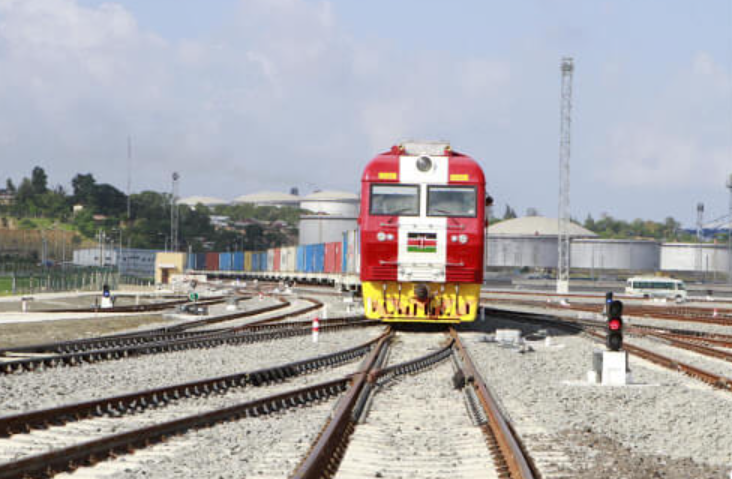
 SGR, FILE
SGR, FILE
Kenya plans to concession Standard Gauge Railway freight operations and support neighbouring countries set up logistics hubs, the Roads and Transport Ministry has said.
This is part of the latest regional and private sector collaboration to further improve trade along the Northern Corridor.
The government is seeking private sector partnerships to develop supportive infrastructure and cargo handling facilities mainly around the Naivasha Inland Container Depot and economic zones along the 475-kilometre line SGR phase 2B (Naivasha-Kisumu) and 2C (Kisumu-Malaba), set for construction at an estimated $5 billion (Sh645.7 billion).
It also plans to concession freight operations on the SGR to Malaba once rail development is complete.
This means private sector players will be allowed to invest in locomotives, carriages, wagons and other vehicles used on a railway to be operated by Kenya Railways, saving the government billions in purchases.
“We have a framework where we are seeking to basically commercialise aspects which are profitable. The government is seeking to build the infrastructure and get investors to do the rolling stock and we concession the freight,” Roads and Transport CS Davis Chirchir.
It will be a second attempt at concessioning the country's railway operations after a previous deal with Rift Valley Railway Investments and KU Railways Holdings which also Uganda failed to bear fruits, leading to termination of an agreement entered in 2006 for the management of the Rift Valley Railways line.
The 25-year contract was terminated in July 2017, citing persistent breaches by the concessionaires including failure to invest, maintain infrastructure and meet concession obligations.
The two companies launched arbitration proceedings in 2020 alleging wrongful termination and breach of key obligations under the agreement with claims exceeding $2 billion (Sh258.4 billion), but has since been dismissed by the London Court of International Arbitration.
Part of support for neighbouring countries on the other hand is the expedition of issuance of title deeds for parcels of land allocated at the Naivasha Economic Zone, to pave way for development.
Uganda was in 2019 offered land to build a logistics facility at Naivasha, which would be used to handle its imports and exports, with the country being the biggest transit destination for cargoes coming through Mombasa.
In December 2020, Kenya allocated 10 acres of land to South Sudan to build a cargo yard at the Naivasha Industrial Park, which was followed by the allocation of 9.8 acres to Rwanda with Burundi also being brought on board.
However, delays in issuance of titles have slowed down development by the respective countries.
“We have made provision of land and it is of interest in our part for these states to be able to have local presence including clearing offices, to be able to clear their goods and manage some of their sensitive cargos, or the other kind of commercial cargos they have,” Chirchir said, affirming the government’s commitment to give titles and other incentives.
The Kenyan government, he said, wants the countries served by the 1,700-kilometre Northern Corridor, which runs from the Port of Mombasa into the hinterland, to fully operate logistics hubs in Kenya even as the SGR is being extended to Malaba.
The Northern Corridor Transit and Transport Coordination Authority (NCTTCA) Executive Secretary, John Deng, said land titles will pave way for feasibility studies and investments on the properties which have since remained undeveloped over the years.
“We request the National Treasury and Ministry of Lands in Kenya to hand hold our member States, offer the required incentives and waivers, as well as define the limits of the land parcels granted for ease of identification and development,” Deng said.
The neighbouring countries are expected to put up Special Economic Zones (SEZs) and logistic hubs including warehouses for handling their respective cargoes.
This comes even as Kenya pushes for financing of the extension of the SGR, with construction expected to commence in September.
According to Chirchir, compensation of individuals affected by the project which will run through Narok, Bomet, Nyamira, Kisumu and finally Busia county, has started.
Feasibility and Environmental and Social Impact studies have so far been completed, with the Kenyan government committing to develope the project concurrently with Uganda.
The planned move by the government falls within the Shippers Council of Eastern Africa (SCEA) asks, where it has been seeking to have private sector allowed to invest in freight wagons and enter contractual arrangements with Kenya Railways on operations, to increase cargo-handling capacity.
Countries with open access for rail include South Africa,
Brazil and a number of European countries.
Kenya Railways has been actively increasing its wagon capacity. In the 2024-2025 financial year, it procured 500 new wagons, including 300 for the SGR and 200 for the Metre Gauge Railway.
Each SGR freight train has an average capacity of 4,000 tonnes and can carry 108 TEUs (containers), but there has been delays when cargo volumes go up at the Port of Mombasa.










.jpg&w=3840&q=100)

